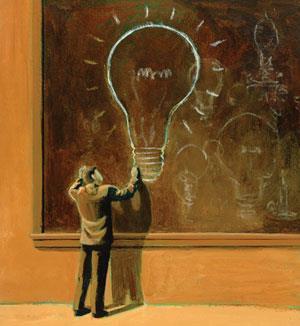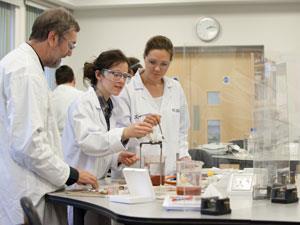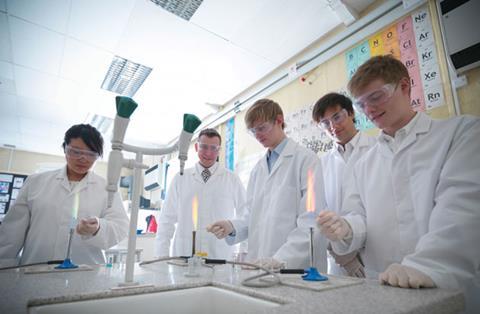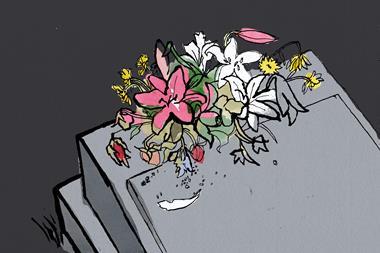Most people’s first taste of chemistry is in the classroom, but are tomorrow’s chemists getting the education they deserve? Kathryn Roberts finds out

When it comes to inspiring and educating the next generation of chemists, few would argue that top of the wish list is a good chemistry teacher. Following closely is a modern, relevant curriculum that is underpinned by conceptual and practical chemistry, and a rigorous yet fair assessment regime that is understood by all stakeholders and respected internationally.
If only life were that simple. In the UK, education is a political football, passed between changing secretaries of state and successive governments. Continuous cycles of reform over the years, run on political timescales, have left many teachers feeling ‘deprofessionalised’ and questioning whether reforms carried out on such short timescales can ever have any real impact on the quality of teaching and learning. For the sake of achieving high quality science education for all, many teachers and educationalists seem to agree that an independent curriculum and assessment body, both underpinned by research evidence, is the way forward. Importantly, any major changes would be piloted before implementation, and once in place would remain for several years to give stability to the system.
Current reforms
According to Katie Farrington of the UK government’s Department for Education (DfE), speaking at this year’s annual Score (science community representing education) conference, the current reforms to science education are driven by England’s fall in the rankings of international comparison tables in science and maths for 11 to 14-year olds, and ‘the desire to get more pupils to study maths and science post-16’.
The government, based on what many believe is selective evidence of what the world’s highest performing countries do, says it wants a science curriculum that is ‘challenging and rigorous, with the breadth and depth of subject knowledge that compares well to the best curricula in the world’. There is to be more detail to the specifications (the mathematics requirements will be spelled out for each key stage, for example); all learners will have the opportunity to take higher and lower tier papers at GCSE; and modular assessment is out – GCSE and A-level exams will be taken at the end of the two-year courses.
We need teachers who are competent, confident, enthusiastic and inspirational
Jim Iley
Alongside curriculum and assessment reform, the government acknowledges it needs to attract and retain more physics and chemistry graduates into the teaching profession, so there is a promise to continue funding subject-knowledge enhancement courses and science learning centres to support continuing professional development (CPD) and teacher training. There is a move away from university-based initial teacher training to various schemes that put teacher training and recruitment under the control of schools. And mathematics education up to the age of 18 is a high priority.
Under the current reforms, there is no longer a requirement for all schools to follow a national curriculum, and computer science is being proposed as part of the science options for the English Baccalaureate accountability framework. A balanced science education up to 16, covering biology, chemistry and physics, is therefore beginning to look vulnerable. So how does the chemistry community ensure an inspirational education in chemistry for all students?
Inspirational teachers
Jim Iley, executive director of science and education at the Royal Society of Chemistry (RSC), is clear on the matter. ‘It begins and ends with teachers. We need teachers who are competent, confident, enthusiastic and inspirational. Competence comes down to their facility with the subject – people with better degrees are likely to have more competence in their subject and this gives them confidence to step outside the curriculum when appropriate and follow different lines of enquiry, beyond the specifications.’ The RSC, Iley explains, has also set itself a challenge – to ensure that all post-14 students of chemistry are taught by a chemistry specialist by 2017.

For these reasons, he says, the RSC has collaborated with the National College of Teaching and Leadership to set up a scholarship scheme to support chemistry graduates with a first or upper second class degree to teach. Iley is quick to acknowledge, however, that the class of degree alone is no guarantee of success as a teacher. Teachers also need to be able to relate and engage with children in a way that enables them to be fascinated by their subject and to demonstrate how it relates to the modern world, he says. ‘The RSC would accept students for the scheme with a lower second class degree if they had further evidence of subject knowledge, such as a masters-level qualification in science,’ Iley adds.
Justin Dillon is a science education researcher at King’s College London in the UK, and has been training chemistry teachers for over 30 years. ‘There is no correlation between subject knowledge and good teachers,’ he points out. ‘Some of the worst teachers we’ve had at King’s have had exceptional subject knowledge but haven’t been able to understand why children find concepts hard. Equally important are liking children and wanting all children to learn – chemistry is a subject for everybody, not just a minority – and the ability to be self-critical and reflective. You can improve people’s subject knowledge, but it’s very hard to change attitudes.’
Last year’s Score conference – a one-day meeting of around 150 predominantly science teachers, educationalists and academics – concluded that an effective teacher in the sciences requires a good science background coupled with sound pedagogical knowledge. Some teachers agreed that the latter was more important than subject knowledge and that class of degree was not important. There was also strong agreement among teachers that the current provision in England and Wales is too geographically variable. There needs to be a more coherent model that is underpinned by an expectation that all teachers should be given time to reflect on and improve their teaching skills and subject knowledge throughout their careers.
Dillon agrees: ‘There needs to be long-term classroom-based professional development. The current provision of one to two day courses often has zero impact on classroom practice.’ Science education research, explains Dillon, has a lot to say about which strategies are effective, and what problems children have when learning different concepts, and it is important that this information gets to teachers.
One of the best ways of motivating students in science is to allow them to do real research’
Becky Parker
John Dexter, deputy head and chemistry teacher at Trinity School in Nottingham in the UK, believes the internet has a role to play here: ‘The sharing of good practice is being revolutionised by things like Twitter and blogging. Teachers can find out what other teachers think and do to address difficult topics and student misconceptions. And there are some superb resources available from the RSC, the ASE [Association for Science Education] and the National Science Learning Centre to support CPD.’
Becky Parker, director of a research centre for science at Simon Langton Grammar School for Boys in Kent, UK, hankers after a different CPD model that will resonate with many science teachers. ‘One of the best ways of motivating students in science, we find, is to allow them to do real research, and the same is true for science teachers. We want to get funding so that our science teachers can spend half a day a week doing science research alongside their students. This will encourage teachers to keep up-to-date with their subject and keep science alive for them. The knock-on effects to their teaching, and student learning, we find, are phenomenal.’
Whether the current trend for teacher training to move away from universities to schools will benefit chemical education in the long term is another moot point. ‘The RSC,’ says Iley, ‘takes an agnostic view on the method as long as the components – classroom practice and management, underpinned by theoretical knowledge of how children learn at different ages – are covered and the output – appropriately trained inspirational teachers – is achieved.’
But others are concerned that a fragmented initial teacher training system with no one taking control of recruitment numbers might lead to more problems in the long term than it will solve in the short term. The school-led initiative, School Direct, for example, has failed to recruit to its targets this year, which will lead to a shortage in science teachers in the future. There is also a danger with reduced numbers allocated to PGCE courses that university departments would be forced to close their teacher training arm, leading to a shortfall of provision.
There are also worries that fragmentation will lead to variable and potentially diluted standards in the trained teachers, which would again undermine the profession. And some people comment that teaching schools cannot deliver high quality training or CPD without huge investment and additional resources, and will simply lead to too many good teachers being lured away from the chalk-face and into management roles. Science teachers, Dillon suggests, would be better encouraged to do a masters-level qualification in education so that they get quality time to reflect on their practice.
Assessing assessment
That brings us to the tools of the trade – the curriculum and assessment. There is no doubt there have been some innovative and inspirational developments in the school science curriculum over the past couple of decades, underpinned by a strong research base. In 1998, Robin Millar and Jonathan Osborne, UK science education specialists at the University of York and King’s College London respectively, published a seminal report Beyond 2000: Science education for the future. This identified a mismatch between the aims and philosophy of a national curriculum for all and a science curriculum aimed at youngsters who would go on to study the sciences at A-level. The importance of scientific literacy was emphasised, which eventually led to the suite of GCSEs, Twenty-first century science, that was introduced in the mid-2000s.

‘Twenty-first century science is the most innovative curriculum development in the past 20 years because it has provided different routes for all youngsters with varying abilities, outlooks and interests,’ Dillon says. ‘If we want a model for chemical education for the future, we should start here; it allows individuals to make a decision on whether they want to become broadly scientifically literate or whether they want to study science at a more advanced level.’
Today, however, many teachers and educationalists believe that the key to high quality chemical education is high quality assessment. Assessment inevitably determines what is taught in the classroom, when it is taught and how it is taught. But very little time has been spent on developing assessment, leaving it a neglected area in terms of education reform.
‘If you get the assessment right,’ says Iley, ‘teachers could use multiple examples to address the assessments and would not be constrained by a curriculum. We should be starting from learning outcomes – what we want students to be able to do – and work out what this means in terms of assessment. The problem with the current reforms is that they are all about inputs, because the government can control these, rather than the outcomes, which it can’t.’
Millar agrees: ‘When people talk about the need for more mathematical demand at both GCSE and A-level, it would help enormously if they gave examples of the kinds of questions and assessment activities that they would like to see. Using questions to clarify intended learning outcomes is the principle behind our York Science Project.’
With funding from the Salters’ Institute, the York Science Project aims to embed assessment into routine classroom practice. The project, explains Millar, is informed by research evidence on formative assessment, which finds that this type of ongoing assessment can make a significant difference to learning. ‘There comes a point when teachers have to believe that a better conceptual understanding and the kind of understanding that are promoted by good formative assessment will lead to students getting better scores in summative tests even though the style of those questions might be rather different.’
But what constitutes an inspirational assessment activity? Peter Wothers, teaching fellow in the department of chemistry at the University of Cambridge in the UK believes that a competition his department runs for AS-level students, The Cambridge Chemistry Challenge, provides some insight into the type of assessment needed.
Students are not used to answering questions where they are really required to think
Peter Wothers
The written paper consists of two questions based on contemporary chemistry-related issues and featured the horsemeat scandal this year, for example. ‘We wanted to show that chemistry is interesting and relevant and can be thought-provoking in a way that too often the A-level exams are not,’ Wothers explains. ‘The questions are based on material they would have learnt, but is presented in an unfamiliar context which requires the students to think.’
While several hundred candidates achieved over half marks, Wothers was surprised that so many of the more able students achieved a low score. ‘The results illustrate that the students are not used to answering questions where they are really required to think – they panicked even though none of this was beyond them,’ he explains.
Wothers concludes that the problem comes down to a rigid set of A-level specifications, which encourages a mentality where if ‘it’s not in the specifications, students don’t need to know it and they won’t be asked about it’. Assessments, he believes, have become too formulaic – students know what sort of questions will be asked and focus on learning the answers. He believes that there is now an urgent need to develop more creative and challenging assessments that encourage students to think for themselves and use the knowledge they have learnt.
Practical chemistry
No education in chemistry is meaningful without practical work. Iley drives the point home: ‘Experimental science is how anybody finds out about the world. Practical work should be an integral part of the chemistry curriculum, neither an add-on nor something you don’t have to do. It should be driving the learning, and its assessment should ensure this.’

‘There needs to be more emphasis on group and outdoor activities – simply following recipes, as is common, won’t inspire anyone,’ adds Dillon. ‘We need experiments that encourage children to think critically about science. By focusing on their local environment, for example, students can collect data and look for patterns to make hypotheses and then compare their data with those from other parts of the country – this would give them an idea of how science works and that it is a collaborative activity.’
Ironically, GCSE triple science, because it is given the same time as double award science in the school curriculum, is having the effect of reducing the amount of practical work done in many schools. So youngsters who have the highest aspirations of science are doing the least amount of practical work, explains Dillon. Further, the findings of recent research commissioned by Score reveal there is huge variation in the amount of funds state schools and sixth form colleges are allocating to practical science, which needs to be addressed if schools are to provide engaging science lessons. Score, in consultation with teachers, has produced a set of benchmarks for both primary and secondary practical science, which should go some way to give science teachers what they need to provide a complete education in the sciences.
There is a role here too for technology. While no one would advocate using technology to replace high-value hands-on practical work, Dexter says ‘Technology can be used to inspire, to enrich and to clarify the science by showing experiments that I cannot do in the classroom. Martin Poliakoff’s YouTube videos, for example, which give an experiment for every element in the Periodic Table, can be used to inspire pupils and their teachers.’
In the final analysis, giving youngsters a quality education in chemistry comes down to the teacher. ‘The job of inspiring youngsters is with me in the classroom,’ says Dexter. ‘Let me be the judge of what I think will inspire my students. Let me choose the tools instead of constraining me by adding more content that is either dull or difficult, and don’t make assessment drive the learning.’
Kathryn Roberts is a science writer based in London, UK












No comments yet